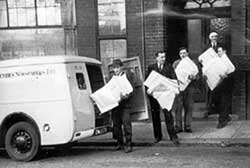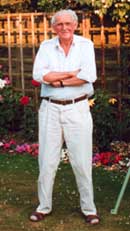 |
|
Now aged 80, Andy Wilsher still lives locally, having after the war risen to a senior managerial position with the Home Counties News Paper Group. In a recent interview he kindly agreed to share his memories of the war time operation. Invalided out of the army, from the very start of the project Andy became involved in the Nachrichten operations, which began approximately a month before D Day. Initially his duties were to help pack first daily production runs of 100,000 copies, into 10 leaflet bombs. The bombs were supplied by the American Air Force and also involved in the packing were George Evans and John Gibbs. John, together with his brother, Richard, was the joint managing director of the Home Counties Group and by D Day 1 million copies of Nachrichten a day were being produced, packed into 100 leaflet bombs. Typeset at Marylands, each day the layout was brought in a sealed box to Home Counties Newspapers, at Alma Street, Luton, for printing and this work was in addition to the regular printing of the 6 local newspapers. Nevertheless very few extra staff were taken on because of the security and with no leave allowed, 7 days a week working was entailed. When printed, the copies were taken to Gibbs and Bamforth at Leagrave. (After the war this became the Leagrave press). Here they were trimmed and packed by a workforce largely sustained with cheese rolls, supplied courtesy of Mrs Ritson, who had charge of the canteen. When the launch of D Day was initially postponed, due to weather conditions, those copies of Nachrichten, already packed into the 100 leaflet bombs obviously became redundant and these were then collected by the Americans to be destroyed. For security reasons the Americans also collected and disposed of the paper waste that accumulated around the rotary printing machines. As well as Nachrichten, also packed into the leaflet bombs, were forged ration books and leave passes, the latter authentic even as to the forged signature of the German officer commanding that particular region. All the leaflet bombs had to be packed and ready by 5pm, to be transported by American lorries to the airfield. Once the lorries had left, to confirm they were on their way a telephone call to the airfield would be made, stating only the code word for the day and the time of departure. At first the leaflet bombs were flown out from an air base in North Bedfordshire but eventually Cheddington became the designated airfield, employing B17s. As Mr Wilsher helped to pack the very first Nachrichten leaflet bomb, John Gibbs especially wanted him to also help pack the last but unfortunately Andy had recently been injured in a motoring accident. Nevertheless he dutifully turned up for this historic occasion, his head swathed in bandages. |
|


